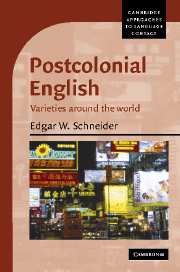Book contents
- Frontmatter
- Contents
- List of maps, figures, and tables
- Series editor's foreword
- Preface and acknowledgments
- List of abbreviations
- 1 Introduction
- 2 Charting the territory: Postcolonial Englishes as a field of linguistic investigation
- 3 The evolution of Postcolonial Englishes: the Dynamic Model
- 4 Linguistic aspects of nativization
- 5 Countries along the cycle: case studies
- 6 The cycle in hindsight: the emergence of American English
- 7 Conclusion
- Notes
- References
- Index of authors
- Index of subjects
4 - Linguistic aspects of nativization
Published online by Cambridge University Press: 15 December 2009
- Frontmatter
- Contents
- List of maps, figures, and tables
- Series editor's foreword
- Preface and acknowledgments
- List of abbreviations
- 1 Introduction
- 2 Charting the territory: Postcolonial Englishes as a field of linguistic investigation
- 3 The evolution of Postcolonial Englishes: the Dynamic Model
- 4 Linguistic aspects of nativization
- 5 Countries along the cycle: case studies
- 6 The cycle in hindsight: the emergence of American English
- 7 Conclusion
- Notes
- References
- Index of authors
- Index of subjects
Summary
From a strictly linguistic perspective, the core component and the most interesting parameter of the Dynamic Model is certainly the process of structural nativization, the emergence of locally distinctive linguistic forms and structures. This is a phenomenon which calls for explanation, and so the present chapter will look specifically into the structural, linguistic properties of PCEs and the issue of where they may come from. Questions that will be raised include the following:
Are there any features which tend to occur in many PCEs, despite widely varying first-language backgrounds, historical evolution processes, and language contact situations?
Are there similarities between the ways in which these varieties are conceptualized?
Are there any fundamental principles of language evolution which account for their emergence?
More specifically, which linguistic processes are responsible for the individual structural properties observed in PCEs?
How does “structural nativization” proceed in detail?
While some twenty years ago knowledge of features of PCEs was still anecdotal, by now many investigations from a wide range of countries have been published, and a few helpful surveys of linguistic features shared by PCEs are available. Amongst the earliest were Wells (1982), for pronunciation only; Platt, Weber, and Ho (1984), with useful summaries of overall tendencies; and Kachru (1986, 1992). Textbooks with a strong emphasis on linguistic features include Trudgill and Hannah (2002, in its fourth edition); Bauer (2002), focusing upon native-language varieties, i.e. settlement colonies, only; and Melchers and Shaw (2003).
- Type
- Chapter
- Information
- Postcolonial EnglishVarieties around the World, pp. 71 - 112Publisher: Cambridge University PressPrint publication year: 2007



